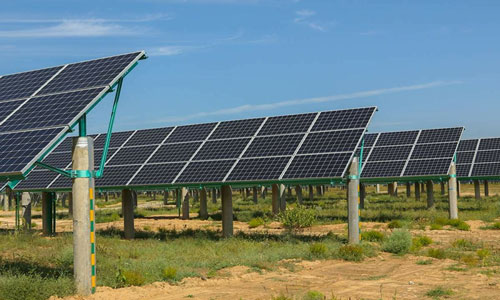Chinese photovoltaic companies are ramping up efforts to embrace the low-carbon development trend in countries along the Belt and Road against the backdrop of China’s commitment to make the Belt and Road Initiative (BRI) a platform for advancing sustainable development.
While China’s carbon neutrality goal is conducive to enhancing the upgrading and transformation of the manufacturing industry and reducing costs through mass production, partner countries are able to access to the new energy solutions from China in the acceleration toward eco-friendly growth, experts said.
The trend is already gaining momentum despite the epidemic and trade complexities that have disrupted international investment and cooperation.
The latest study by the IIGF Green Belt and Road Initiative Center of the International Institute of Green Finance (IIGF) at the Central University of Finance and Economics (CUFE) in Beijing shows that overall investments in the BRI in 2020 were about $47 billion, a decline of 54 percent to investments in 2019.
However, renewable energy investments such as solar, wind and hydro topped the table of overseas energy investments for the first time, raking in 57 percent of investments in the sector, constituting the majority of Chinese overseas energy investments, with the increase of their share from 38 percent in 2019 to 57 percent in 2020, despite the total decrease in BRI investments.
Market trend While China has become the world’s largest producer and adopter of renewable energy, with the installed capacity of hydropower, wind power and photovoltaic power leading the world for many years, the BRI has provided a broad platform for domestic companies to accelerate energy infrastructure connectivity and promote clean energy cooperation.
The move toward sustainable energy has seen little disruption even amid the outbreak in 2020 when China’s photovoltaic industry bucked the trend and maintained a continuous growth driven by resilient demand.
A new energy company Jinko Solar saw its full-year revenue and component shipments in 2020 jump significantly compared to 2019 results, driven up by the booming demand for sustainable development for countries along the route despite the challenges from the epidemic and the trade complex.
Jinko Solar’s annual shipments in 2020 reached 18,771 megawatts, up 31.4 percent year-on-year, with the total revenue reached $5.38 billion, up 18.1 percent year-on-year, according to the latest fiscal report that the company sent to the Global Times over the weekend.
By the end of 2020, the company’s module shipments totaled 70 GW, putting the company at the top of the industry.
The Hebei-based solar panel manufacturer Yingli Green Energy, one of the leading industry players, is also in the pioneering group of the new energy trend.
Among all the projects they participated, their first cooperative project of photovoltaic power station in Algeria not only contributed to reversing the local power shortage, but also played an important role in stimulating local employment and promoting the common development of the upstream and downstream of the radiation industry chain.
During the construction process, more than 600 Chinese people came to Algeria. At the peak of the construction, more than 2,000 local employees were employed, including more than 800 Malian refugees.
In addition to the product exports, Yingli Green Energy has hosted four consecutive international training courses on photovoltaic technology and application under China’s Ministry of Science and Technology, training nearly 400 students from Asian and African countries on advanced photovoltaic industry application technologies, and exported more than 20 related technical achievements to more than 10 countries.
‘We are now focusing on exports of pv equipment and have provided photovoltaic solutions for dozens of partner countries ranging from Pakistan in South Asia to Egypt in North Africa, with the export shipments of pv products accounted for about 30 percent of the total, and the demand is growing,’ a source with the company told the Global Times on Sunday.
Data released by the US Enterprise Public Policy Institute shows that from 2014 to 2020, China’s investment in renewable energy in the Belt and Road projects increased by nearly 40 percent, surpassing the investment in fossil energy.
‘[China’s] technological advances have reduced the cost of photovoltaic and wind power generation by more than 80 percent in the past decade, and there is much more to come,’ said Ma Jun, director of the Beijing-based Institute of Public and Environmental Affairs.
Ma’s words echoed with the data that China Photovoltaic Industry Association (CPIA) shared with the Global Times, which shows that China’s homemade polysilicon, silicon wafer and battery wafer, the important components for solar energy, now account for more than two thirds of the global cumulative output.
‘We need to strengthen international cooperation on setting global green standards, promote conformity assessment and mutual recognition mechanism, and do better job in the link up of green trade rules with import and export policies,’ said the association.
Market prospects Given the pace of development of recent years, China’s photovoltaic technology is expected to make a further leap in the scale of international cooperation and investment, focusing on BRI partner countries where the market prospect for new energy is broad, industry experts said.










